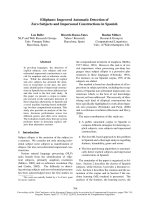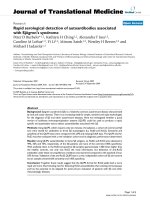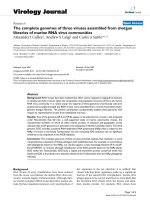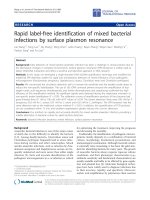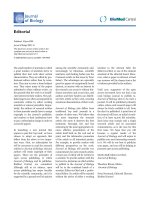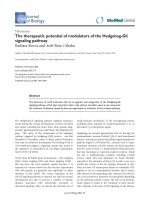Báo cáo sinh học: "Rapid PCR detection of group a streptococcus from flocked throat swabs: A retrospective clinical study" ppsx
Bạn đang xem bản rút gọn của tài liệu. Xem và tải ngay bản đầy đủ của tài liệu tại đây (246.22 KB, 5 trang )
RESEARCH Open Access
Rapid PCR detection of group a s treptococcus from
flocked throat swabs: A retrospective clinical study
Robert Slinger
1*
, David Goldfarb
2
, Derek Rajakumar
1
, Ioana Moldovan
1
, Nicholas Barrowman
3
, Ronald Tam
1
and
Francis Chan
1
Abstract
Background: Rapid diagnosis of GAS pharyngitis may improve patient care by ensuring that patients with GAS
pharyngitis are treated quickly and also avoiding unnecessary use of antibiotics in those without GAS infection.
Very few molecular methods for detection of GAS in clinical throat swab specimens have been described.
Methods: We performed a study of a laboratory-developed internally-controlled rapid Group A streptococcus
(GAS) PCR assay using flocked swab throat specimens. We compared the GAS PCR assay to GAS culture results
using a collection of archived throat swab samples obtained during a study comparing the performance of
conventional and flocked throat swabs .
Results: The sensitivity of the GAS PCR assay as compared to the reference standard was 96.0% (95% CI 90.1% to
98.4%), specificity 98.6% (95% CI 95.8% to 99.5%), positive predictive value (PPV) 96.9% (95% CI 91.4% to 99.0%) and
negative predictive value (NPV) of 98.1% (95% CI 95.2% to 99.2%). For conventional swab cultures, sensitivity was
96.0% (95% CI 90.1% to 98.4%), specificity 100% (95% CI 98.2% to 100%), PPV 100%, (95% CI 96.1% to 100%) and
NPV 98.1% (95% CI 95.2% to 99.3%)
Conclusions: In this retrospective study, the GAS PCR assay appeared to perform as well as conventional throat
swab culture, the current standard of practice. Since the GAS PCR assay, including DNA extraction, can be
performed in approximately 1 hour, prospective studies of this assay are warranted to evaluate the clinical impact
of the assay on management of patients with pharyngitis.
Keywords: PCR, rapid, internally-controlled, LCGreen, Group A Streptococcus, pharyngitis, flocked swab
Background
Rapid diagnosis of Streptococcus pyogenes,commonly
referred to as group A streptococcus (GAS), from th roat
specimens may be useful for patient management, both
ensuring that patients with GAS pharyngitis are treated
quickly and also avoiding unnecessary use of antibiotics in
those without GAS infection. Surprisingly, there have been
very few reports of nucleic acid (NA) amplification assays
for rapid GAS detection from throat swabs [1,2]. The lack
of published reports in this area may reflect concerns
about the costs and complexity of NA amplification meth-
ods relative to culture and antigen detection methods.
We therefore designed an internally-controlled, rapid
and relatively inexpensive PCR assay for GAS pharyngi-
tis, and retrospectively evaluated this assay using
archived throat swab specimens. The assay made use of
recent innovations in specimen collection a nd nucleic
acid amplification b y using the new flocked swabs for
specimen collection and by using a newer intercalating
dye, LC Green, for amplicon detection [3,4].
Methods
PCR primers and internal amplification control design
We chose the dnaseB gene as our target since this gene
appears to be both present in all S. pyogenes and also
unique to this organism [5]. We designed a PCR primer
pair to amplify a dnaseB gene sequence using the Primer3
program [6]. In order to determine if PCR inhibition was
present in any specimens, we designed a competitive
* Correspondence:
1
Department of Laboratory Medicine, Children’s Hospital of Eastern Ontario,
University of Ottawa, Ottawa, ON, Canada
Full list of author information is available at the end of the article
Slinger et al. Annals of Clinical Microbiology and Antimicrobials 2011, 10:33
/>© 2011 Slinger et al; licensee BioMed Central Ltd. This is an Open Access article distributed under the terms of the Creative Co mmons
Attribution License (http://creative commons .org/licenses/by/2.0), which permits unre stri cted use, distribution, and reproduction in
any medium, provided the original work is properly cited.
internal amplification control (IAC) oligonucleotide that
would be amplified by the GAS primers selected, but have
a lower melting temperature (T
m
)
.
The primers and the
IAC sequences are shown in Table 1.
PCR protocol
The primers and the internal control oligonucleotide were
synthesized by Integrated DNA Technologies, Inc (Coral-
ville, ID). PCR reactions were performed in 10 μL volume,
including 4 μL of Light Scanner master mix containing
the LCGreen Plus + dye (Idaho Technology Inc., Salt Lake
City, UT), a 0.5 μmol/L concentration of each primer, a 1
picomolar conc entration of internal control oligonucleo-
tide and 1 μL of specimen DNA.
The thermocycler (RapidCycler II, Idaho Technology
Inc.) protocol consisted of 40 cycles of 95°C denaturation,
60°C annealing, 72°C extension with a 10 second hold at
each temperature and a programmed transition rate of
9.9°C per second, with a total run time of 35 minutes.
After PCR, samples were transferred to the high-resolu-
tion melting instrument (HR-1). A rate of 0.3°C per sec-
ond was used when measuring the fluorescence change of
the sample in a temperature range of 60°C to 90°C. The
derivative of the measured fluorescence plotted against
temperature was displayed using the HR-1 software and
the peak of these curves was measured to obtain the
amplicon T
m
.
Specificity panel
Prior to clinical specimen testing, we verified primer
specificity in silica using the BLAST tool, and in vitro
against a panel of DNA extracts from a collection of
reference bacterial strains. These included Streptococcus
dysgalactiae subsp. equisimilis (large-colony Lancefield
antigen Group C and G positive beta-hemolytic strepto-
cocci), S. agalactiae (Group B streptococcus), S. inter-
medius, S. constellatus, S. anginosus, S. p neumoniae
ATCC 49619, and Streptococcus saliva rius ATCC 13419
Escherichia coli American type culture collection
(ATCC) 25922, Haemophilus influenzae ATCC 49766,
H. influenzae ATCC 49247, Haemophilus parainfluenzae
ATCC 7901, K. pneumoniae ATCC 700603, Moraxella
catarrhalis ATCC 25238, Staphylococcus aureus ATCC
29247, Neisseria gonorrhoeae ATCC 49226, Neisseria
lactamica ATCC 23970, Pseudomonas aeruginosa
ATCC 27853, Enterococcus faecalis ATCC 29212.
GAS PCR retrospective clinical specimen study
We used specimens for the PCR evaluation that had been
previously coll ected as part of a study comparing flocked
swabs to conventional swabs for detection of GAS by cul-
ture [3]. Physicians obtained throat specimens from
patients seen in the Children’ sHospitalofEastern
Ontario (CHEO) Emergency Department, using dual
swabs with flocked and conventional swab attached to
the same base. The initial study was conducted from
September to December 2007. Research Ethics Board
approval was obtained and consent was required from
each participant.
After samples were collected, the flocked swab was
removed from the dual swab applicator base and placed
into a transport tube containing 1 ml Liquid Stuarts
transport media. The conventional swab was placed i n a
traditional throat swab transport tube. Both t ubes were
then sent to the on-site bacteriology laboratory.
The conventional swab was used to directly streak a 5%
blood agar (BA) plate. The transpor t tube containi ng the
flo cked swab was briefly vortexed. The flocked swab was
then used to directly streak a second BA plate and
100 μL of the liquid media was streaked onto a third BA
plate. Plates were incubated anaerobically for 24 hours
prior to examination. Group A streptococci were identi-
fied by hemolysis, colony size, latex agglutination and
bacitracin susceptibility. Five-hundred microliters of the
liquid transport media was saved frozen at -80°C for
future DNA extraction.
GAS PCR study specimens
Three-hundred forty-four dual swabs were collected in
the swab comparison study. Six swabs were excluded
from analysis since they were improperly collected. Of
the 338 liquid transport media specimens saved, 32 were
consumed in preliminary comparisons of a variety of
nucleic a cid extraction methods. Three-hundred and six
(90.5%) of the properly collected fluid specimens were
thus available for testing with the GAS PCR assay.
DNA extraction
The saved volume of flocked swab transport medium was
thawed and then centrifuged for 3 minutes at 16000 × g.
The supernatant was removed and 40 μ LofPrepMan
Ultra r eagent (Applied Biosystems, Foster City, CA) was
added to the pellet and vortexed for 30 seconds. This was
Table 1 Primers and internal amplification control (IAC) oligonucleotide sequences (5’-3’ direction) for group A
streptococcus (GAS) dnaseB assay
dnaseB forward primer TGA TTC CAA GAG CTG TCG TG
dnaseB reverse primer TGG TGT AGC CAT TAG CTG TGT T
IAC TGATTCCAAGAGCTGTCGTGatcaatataacaaacacttgcatatatatact
tacgaaactaataactaaataatcaatataaatACACAGCTAATGGCTACACCA
Slinger et al. Annals of Clinical Microbiology and Antimicrobials 2011, 10:33
/>Page 2 of 5
then heated at 100°C for 10 minutes, and then centri-
fuged again for 3 minutes at 16000 × g.Thesupernatant
was transferred to a new tube and saved at -80°C until
testing.
Repeatability and reproducibility
To assess repeatabilit y, four PCR and cul ture positive
and two negative clinical samples were run in triplicate
twice in one day by the same operator using the same
lot of master mix [7]. We used two specimens from
which 1-10 CFU of GAS were grown in culture as
“weak positives” to challe nge the assay. To assess repro-
ducibility, the same samples were then tested in tripli-
cate one w eek later by a different technologist using a
different lot of master mix [7].
Main outcome measure and statistical analysis
The main outcome measures of the study were the perfor-
mance characteristics (sensitivity and specificity, positive
and negative predictive values) of a) the PCR assay and b)
the conventional swab culture in comparison to the refer-
ence standard results. For statistical analysis, we used as
the reference standard a positive culture for GAS from
either or both of the two BA plates inoculated from the
flocked swab specimen (w ith the transport liquid or
directly with the flocked swab). Confidence intervals for
performance characteristics were computed using the
Wilson score method [8]. The differences between sensi-
tivities were evaluated with the McNemar’stest.
Results
GAS PCR retrospective clinical specimen study (Table 2)
The sensitivity of the GAS PCR assay as compared to the
reference standard was 95/99 (96.0%, 95% CI 90.1% to
98.4%) with a specificity of 204/207 (98.6%, 95% CI 95.8%
to 99.5%). The positive predictive value (PPV) was 95/98
(96.9%, 95% CI 91.4% to 99.0%) and the negative predictive
value (NPV) 204/208 = (98.1%, 95% CI 95.2% to 99.2%).
Regarding the four PCR-negative reference assay-positiv e
specimens, cultures of the flocked swab liquid media, from
which the DNA was extracted for PCR, grew GAS in very
light quantities in 3 specimens and was GAS culture-nega-
tive from the fourth specimen.
For the conventional swab cultures, sensitivity was also
95/99 (96.0%, 95% CI 90.1% to 98.4%), with a specificity of
207/207 (100%, 95% CI 98.2 % to 100%), PPV of 95/95
(100%, 95% CI 96.1% to 100%) and NPV of 207/211
(98.1%, 95% CI 95.2% to 99.3%)
The mean T
m
for the dnaseB peaks was 79.76°C (SD =
0.35°C). The mean T
m
for the IAC peaks was 76.89°C
(SD = 0.36°C). Figure 1 illustrates examples of the deriva-
tive melt curves for one GAS PCR-positive and two GAS
PCR-negative throat swab specimens.
Indeterminate results
Melting peak graphs for ten specimens of 306 (3.3%, 95%
CI 1.8% to 5.9%) were judged to be indeterminate and
required repeat PCR testing. This group of ten included
two specimens with neither IAC nor dnaseB peaks seen
on the initial PCR run, and eight specimen results that
showed peaks with heights between 5-15 units within the
melting temperature range of the dnaseB amplicon. On
repeat testing of these 10 specimens, all 10 gave results
which could be readily interpreted. (Eight were found to
be GAS PCR-negative and two were GAS PCR-positive).
Of note, since a competitive internal cont rol design
was used, the presence of either the IAC amplicon or
the dnaseB amplicon indicated no PCR inhibition had
occurred. Among the dnaseB- positive spec imens, both
dnaseB and IAC peaks were seen in 36/98 (36.7%) and
the dnaseB peak alone in 62/98 (63.3%).
Table 2 Group A streptococcus (GAS) dnaseB PCR and
conventional swab culture results compared to the
reference standard
Flocked swab cultures*
+-
Group A streptococcus dnaseB PCR assay + 95 3
- 4 204
Conventional swab culture + 95 0
- 4 207
*positive GAS culture on ≥ 1 of the 2 flocked swab blood agar plate cultures
Internal amplification
control peaks
dnaseB pea
k
Figure 1 Group A streptococcus (GAS) PCR derivative melt ing
curves for three flocked throat swab specimens (one GAS PCR-
positive and two GAS PCR-negative specimens). The GAS-PCR
positive specimen shows both an internal amplification control (IAC)
and dnaseB peak. Only IAC peaks are seen in the GAS-negative
specimens, demonstrating that GAS was not detected and, in
addition, that the PCR reaction was not inhibited.
Slinger et al. Annals of Clinical Microbiology and Antimicrobials 2011, 10:33
/>Page 3 of 5
Specificity panel and repeatability and reproducibility
The specificity panel study showed no amplicons that
could lead to false positive GAS results. The 18 qualitative
(positive or negative) PCR results were identical for the
tests performed twice on the same day to assess repeat-
ability as well as for those obtained when testing was per-
formed one week later by a different operator with a
different master mix lot to assess reproducibility.
Discussion
The rapid internally-controlled GAS PCR assay described
performed as well as the currently accepted standard
method of conventional swab culture for GAS detection.
PCR assay sensitivity of 96% was also similar to that seen
in two prior prospective studies comparing PCR to culture
GAS detection from throats swabs. In a study using dot
blot and Southern Blot detection of PCR products from
throat swabs, GAS detection sensitivity was also 96% [1],
while the sensitivity of a fluorescent probe-based PCR
detection method was 93% (82-98% CI) with a specificity
of 98% (96-99% CI) [2].
Although a small number of specimens were refer ence
assay- positive/PCR-negative, culture results from these
specimens indicated that only specimens containing very
low quantities of GAS may possibly be missed by PCR
assay. As well, c olonization of the pharynx with GAS is
relatively common in pediatric patients, and recovery of
GAS in low quantities by culture may not be clinically sig-
nificant, as GAS may be a colonizer rather than the cause
of pharyngitis i n some cases. The high specificity of the
GAS PCR assay ensures laboratories will only rarely
encounter the dilemma of PCR-positive, culture-negative
specimens.
The GAS PCR assay may be useful for clinical labora-
tories. It is relatively rapid, since it can be performed in
approximately one hour, including the DNA extraction
procedure, and as a closed-tube method, has a low risk of
environmental cross-contamination. However, the assay is
less suitable for medical office settings as compared to
rapid antigen detection tests since more manual steps are
required and since the turnaround time may be longer.
The per reaction cost for the GAS LCGreen assay is low,
at approximately $2.40 US, including DNA extraction and
PCR reagents and consumables, but not including swab
costs and personnel time.
The GAS PCR assay also demonstrates for the first time
the clinical usefulness of flocked swabs in liquid transport
media for bacterial molecular assays. Flocked swabs are
created by attaching individual short fibers to an applica-
tor, rather than winding long fibers around the applicator,
as with conventional swabs. Due to this design, flocked
swabs release a larger volume of specimen into the liquid
transport media than conventional wound fiber swabs.
This liquid media can then be used for nucleic acid extrac-
tion for molecular assays. Molecular testing from flocked
swab clinical samples has previously been reported for
detection of viral agents [9], but to our knowledge, this is
the first report to demonstr ate the successful use of PCR
from flocked swab specimens for b acterial identification
using true clinical specimens. (A study using serial dilu-
tions of bacterial reference strains has shown improved
sensitivity for nucleic acid amplification assays using
flocked swabs [10].)
This assay also provides another example of the use-
fulness of LCGreen dye for amplicon detection and
melting analysis. This dye has been used succes sfully for
applications such as duplex and multiplex PCR where
older SYBR Green dyes may be sub-optimal [4,5]. The
SYBR Green dyes have been described, to have a ten-
denc y to bind preferentially to certain amplicons or due
to inhibition of PCR by the dye itself [11]. In contrast,
the LCGreen dye has been used successfully to detect
and differentiated amplicons in duplex and multiplex
PCR assays for the identification of infection agents,
such as Aspergillus spp. and Mycobacterium spp., and
for detection of antibiotic resistance genes [4,12,13].
LCGreen assay could be adapted successfully to any of
several real-time thermocyclers compatible with this dye
[14], so the GAS PCR we describe shou ld be readily
transferable to these instruments.
There are several limitations to our study. First, not all
specimens c ollected in the original flocked swab study
were available for testing with the PCR assay. However,
the proport ion positive for GAS by culture in the origi-
nal study and in this study were similar, suggesting that
this factor would n ot introduced bias into the PCR
study. Secondly, samples were tested retrospectively
aft er being saved frozen rather than being tested imme-
diately after collection. We cannot exclude the possibi-
lity that freezing and thawing may have affected study
results in some way.
A third limitation is that not all samples positive by
the reference standard of positive flocked swab cultures
were detected. The PCR sensitivity w as, however, equal
to that of a wound fiber conventional swab culture,
which is currently the standard of practice in clinical
microbiology laboratories.
Conclusion
The GAS PCR assay appears to be an accurate and rapid
molecular assay for GAS detection in children and ado-
lescents with pharyngitis. Since the GAS PCR assay,
including DNA extraction, can be performed in approxi-
mately 1 hour, prospective studies of this assay are war-
ranted to evaluate the clinical impact of the assay on the
management of patients with pharyngitis.
Slinger et al. Annals of Clinical Microbiology and Antimicrobials 2011, 10:33
/>Page 4 of 5
Acknowledgements
None
Author details
1
Department of Laboratory Medicine, Children’s Hospital of Eastern Ontario,
University of Ottawa, Ottawa, ON, Canada.
2
Department of Pediatrics,
University of Botswana, Gaborone, Botswana.
3
Research Institute, Children’s
Hospital of Eastern Ontario, University of Ottawa, Ottawa, ON, Canada.
Authors’ contributions
RS drafted the primary manuscript. RS and DG designed the PCR assay. NB
performed statistical analyses. DG, RT, FC contributed to study design and
data collection and analysis. DR and IM participated in the performance of
the PCR assay and data analysis. All authors contributed to the preparation
of the manuscript. All authors read and approved the final manuscript.
Competing interests
The authors declare that they have no competing interest s.
Received: 16 May 2011 Accepted: 2 September 2011
Published: 2 September 2011
References
1. Kaltwasser G, Diego J, Welby-Sellenriek PL, Ferrett R, Caparon M, Storch GA:
Polymerase chain reaction for Streptococcus pyogenes used to evaluate
an optical immunoassay for the detection of group A streptococci in
children with pharyngitis. Pediatr Infect Dis J 1997, 16:748-753.
2. Uhl JR, Adamson SC, Vetter EA, Schleck CD, Harmsen WS, Iverson LK, et al:
Comparison of LightCycler PCR, rapid antigen immunoassay, and culture
for detection of group A streptococci from throat swabs. J Clin Microbiol
2003, 41:242-249.
3. Goldfarb DM, Slinger R, Tam RK, Barrowman N, Chan F: Assessment of
flocked swabs for use in identification of streptococcal pharyngitis. J Clin
Microbiol 2009, 47:3029-3030.
4. Erali M, Pounder JI, Woods GL, Petti CA, Wittwer CT: Multiplex single-color
PCR with amplicon melting analysis for identification of Aspergillus
species. Clin Chem 2006, 52:1443-1445.
5. Podbielski A, Zarges I, Flosdorff A, Weber-Heynemann J: Molecular
characterization of a major serotype M49 group A streptococcal DNase
gene (sdaD). Infect Immun 1996, 64:5349-5356.
6. Steve R, Skaletsky HJ: Primer3 on the WWW for general users and for
biologist programmers. In Bioinformatics Methods and Protocols: Methods in
Molecular Biology. Edited by: Krawetz S, Misener S. Totowa: Humana Press;
2000:365-386.
7. Clinical and Laboratory Standards Institute: Verification and validation of
multiplex nucleic acid assays; approved guideline MM17-A. Wayne, PA: 2008.
8. Newcombe RG: Two-sided confidence intervals for the single proportion:
comparison of seven methods. Statistics in Medicine 1998, 17:857-872.
9. Abu-Diab A, Azzeh M, Ghneim R, Ghneim R, Zoughbi M, Turkuman S, et al:
Comparison between pernasal flocked swabs and nasopharyngeal
aspirates for detection of common respiratory viruses in samples from
children. J Clin Microbiol 2008, 46:2414-2417.
10. Chernesky M, Castriciano S, Jang D, Smieja M: Use of flocked swabs and a
universal transport medium to enhance molecular detection of
Chlamydia trachomatis and Neisseria gonorrhoeae. J Clin Microbiol 2006,
44:1084-1086.
11. Giglio S, Monis PT, Saint CP: Demonstration of preferential binding of
SYBR Green I to specific DNA fragments in real-time multiplex PCR.
Nucleic Acids Res 2003, 31:e136.
12. Odell ID, Cloud JL, Seipp M, Wittwer CT: Rapid species identification
within the Mycobacterium chelonae-abscessus group by high-resolution
melting analysis of hsp65 PCR products. Am J Clin Pathol 2005,
123:96-101.
13. Slinger R, Desjardins M, Moldovan I, . Harvey S-B, Chan F: A Rapid High-
Resolution Melting Multiplex PCR Assay to Detect Macrolide Resistance
Determinants in Group A Streptococcus. Int J Antimicrob Agents, in press .
14. Herrmann MG, Durtschi JD, Wittwer CT, Voelkerding KV: Expanded
instrument comparison of amplicon DNA melting analysis for mutation
scanning and genotyping. Clin Chem 2007, 53:1544-1548.
doi:10.1186/1476-0711-10-33
Cite this article as: Slinger et al.: Rapid PCR detection of group a
streptococcus from flocked throat swabs: A retrospective clinical study.
Annals of Clinical Microbiology and Antimicrobials 2011 10:33.
Submit your next manuscript to BioMed Central
and take full advantage of:
• Convenient online submission
• Thorough peer review
• No space constraints or color figure charges
• Immediate publication on acceptance
• Inclusion in PubMed, CAS, Scopus and Google Scholar
• Research which is freely available for redistribution
Submit your manuscript at
www.biomedcentral.com/submit
Slinger et al. Annals of Clinical Microbiology and Antimicrobials 2011, 10:33
/>Page 5 of 5
